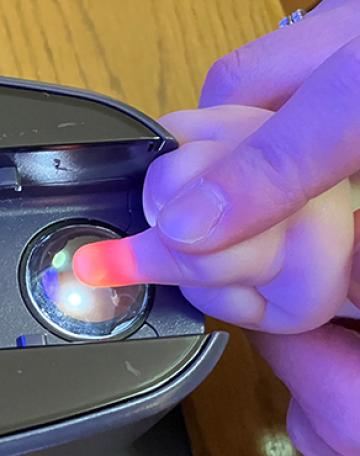Here’s Lookin’ at You, Kid

A scanner “reads” an infant’s finger to detect the quantity of carotenoids that are present in the skin. (Photo courtesy of Nancy E. Moran, Baylor College of Medicine)
Imagine a scanner, with a light like a flashlight, that could quickly detect if an infant is eating a variety of healthful foods. How helpful would that be for parents, caregivers, and medical professionals?
Imagine no more; the scanner is real. Researchers with the Baylor College of Medicine (BCM) in Houston, TX, have proven they can scan a child’s finger or heel and instantly detect whether the child is eating enough fruits and vegetables.
The project, funded by the Agricultural Research Service, began with the knowledge that antioxidants called carotenoids give fruits and vegetables orange, red, and yellow colors. The working hypothesis was that the more fruits and vegetables a child eats, the stronger the carotenoid signal would be in the skin.
Armed with this knowledge, a parent or caregiver could adjust the child’s diet to meet their needs.
“We know that the carotenoids adults eat help to meet vitamin A requirements, support vision health, and reduce risk of cardiovascular disease and cancers. However, we don’t know much about how carotenoids support healthy nutrition during pregnancy and for infants,” said Nancy E. Moran, assistant professor of pediatric nutrition at BCM. “A new, portable device might help us to find out how much carotenoid infants and pregnant people consume so that we could study the linkage between their carotenoid intake and their health.”
A major portion of the project involved testing an existing piece of scanning equipment known as the “Veggie Meter” (made in Utah by Longevity Link Corporation) to see if it could be used successfully with infants. The Veggie Meter uses reflection spectroscopy to detect and quantify carotenoids in the skin of an infant’s fingers and the heels of their feet.
Reflection spectroscopy involves shining a white light from an LED onto the skin. The Veggie Meter device then records the amount and color (or wavelength) of light that bounces back with a detector, and produces a score. That score corresponds with the amounts of carotenoids in the skin, with higher numbers indicating more carotenoid is present. Moran said the principle is similar to the familiar fingertip pulse-oximeter that health care professionals use to measure how much oxygen red blood cells are carrying.
Moran’s research found that the Veggie Meter worked with infants in three age groups, corresponding to their feeding habits: at 4 months of age when they are exclusively consuming human milk or infant formula, at 6 months when they are still drinking lots of milk but starting their first pureed or soft foods, and at 8 months when they are eating both solid foods and milk.
Her findings showed that carotenoid in the skin of exclusively breast milk-fed 4-month-olds correlated directly with their mother’s milk carotenoid content. Further, the skin carotenoids of 8-month-olds correlated with the carotenoids from the vegetables in their diet. Currently, her team is conducting a larger study of children from 4-24 months of age to confirm and expand upon their findings.
According to Moran, many children fall short when it comes to fruit and vegetable intake. A recent report from the Centers for Disease Control and Prevention found that half of children between 1-5 years did not eat a daily vegetable, and 1 in 3 did not eat a daily fruit.
“In order to figure out what infants and pregnant people should eat to maximize their health, we need easy and fast ways to find out what they eat,” Moran said.
“We want to help young children get off to a good start by eating carotenoid-rich foods. A simple and rapid skin measurement can tell us whether the approaches we use to encourage fruit and vegetable intake are working. It also gives us a way to relate a mother’s food intake during pregnancy or lactation to her baby’s nutritional status, so we can learn more about the mother-infant connection.” – by Scott Elliott, ARS Office of Communications
Also in our series on Healthy Eating for Infants and Children:

